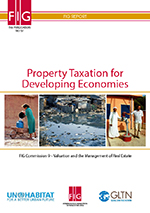FIG PUBLICATION NO. 67
Property Taxation for Developing Economies
FIG Commission 9 – Valuation and the Management of Real Estate
FIG REPORT
Authors: Frances Plimmer and William J McCluskey
FOREWORD
The International Federation of Surveyors (FIG), and Commission 9 (The
Valuation and Management of Real Estate) are proud to present Property
Taxation for Developing Economies, by Frances Plimmer and William J
McCluskey. This work promotes the careful consideration of a transparent,
fair, fast and relatively cost efficient real estate taxation system that
could be applied successfully in some developing and transitional economies.
Many advanced economies rely upon a complex ad valorem property tax regime
that inherently requires relatively high cost and expertise levels. The
authors propose the consideration of a less costly and more easily
established banding system and discuss how and why this system may be
introduced into jurisdictions which lack the necessary resources to
implement a more complex discrete ad valorem assessment system.
This publication touches upon the various types of taxation common among
national economies and narrows its focus specifically upon recurrent
property taxes. The authors examine the primary social need for a recurrent
property tax, various taxation systems, the data, resources and skills
necessary for its implementation as well as ongoing maintenance and social
acceptance factors, as a setting for any successful tax regime and economy.
Within Great Britain and Ireland, a very cost and time efficient system was
needed to overcome some of the barriers in creating a complex discrete ad
valorem recurrent property tax system. From this need, a banding system, was
born. A property value banding system allocates properties into different
categories (or Bands) according to an estimate of some value based criteria
as a basis for the property tax bill. Instead of valuing properties to a
discrete point, the property values are estimated according to a range of
values (Bands). Based on the level of available data, resources, economic,
social and political realities, banding should be considered as a possible
and proven system for producing a speedy, transparent, fair, cheap and
robust tax base.
This work considers the benefits of its wider application across nations in
a theoretical discussion as well as examining case studies showing how this
system has fared in jurisdictions where it is currently being applied. These
case studies expand upon the theoretical discussion by allowing real world
experience, to highlight the strengths and weaknesses of its application in
other countries.
The primary focus of this publication is the application of the banding
system, and this is considered in comparison with discrete ad valorem
taxation systems with greatest emphasis on residential properties.
Residential properties make up the bulk of the real estate tax base in most
regions and a greater flexibility in banding or emphasis on discrete
valuation is likely more appropriate for commercial and unusual property
types. The relative benefits of the banding system should be carefully
considered as either a long term or interim solution in an emerging
economy’s development toward sustainable property taxation. The work herein
gives a clear picture of these two systems, and provides an excellent
resource for decision makers to consider how they may apply in other
countries. This work significantly enhances the current body of work on
recurrent property taxation and is a valuable tool for decision makers at
all levels.
| Steven Nystrom |
Chryssy Potsiou |
| MAI – FIG Chairman of Commission 9 (2015) |
FIG President |
The main objective of the Global Land Tools Network is to contribute to
poverty alleviation and the Sustainable Development Goals (SDGs) through
land reform, improved land management and security of tenure.
This publication discusses a practical and resource-led approach to
implementing an efficient and effective system of taxing real estate in order to
raise funds to pay for much needed community services for the benefit of local
inhabitants.
The focus is on developing a system based on available resources, rather than
a “wish list”, and recommends that the tax be paid by property occupiers (rather
than owners) in the absence of a comprehensive land title register.
Such a system can be both sustainable and scalable, and, with good governance
together with the delivery of appropriate services, can enhance the quality of
life and opportunities for improvement for communities.
The support of the GLTN for this FIG publication demonstrates the continued
commitment of both organisations to their common goal of delivering beneficial
land administration systems for the improved financial, physical and social
environments of the world’s disadvantaged citizens.
Oumar Sylla
Unit Leader, Land and Global Land Tool Network
Urban Legislation, Land and Governance Branch, UN-Habitat
EXECUTIVE SUMMARY
The purpose of this publication is to promote discussion on a relatively simple,
sustainable, speedy and cost-effective system of property taxation which can be
introduced in jurisdictions with a paucity of the resources normally required to
administer a more complex ad valorem property tax regime. This discussion takes
place within the context of existing examples of Banded tax assessments and is
based on the needs and the limited resources of the so-called developing and
transitional economies.
Community growth, in terms of environmental, economic and social development,
is inextricably linked to the provision of public services which facilitate and
enable groups and individuals to improve their circumstances. However, local
government can generally only afford the provision of such services provided the
community contributes in the form of local taxation, generally a levy based on
the value (or some surrogate) of the real estate owned and occupied by
individuals, companies and other groups.
There is a wide range of different forms of local taxation applied throughout
the world, but most rely to a greater or lesser extent on complex economic,
technical and human resources. Similarly, to tax property owners, a
comprehensive and up-to-date database of registered land owners is required. But
how can local governments respond to the needs of their communities for public
services when such resources are absent?
This report demonstrates the development of a property tax system built
around available resources, rather than a “wish list”. Two case studies
illustrate the successful introduction of the Banding of tax assessments, in
contexts where speed and low cost of introduction were critical, and where
tax was imposed on residential occupiers (in the absence of a complete and
up-to-date register of owners).
Banding works on the principle of grouping together dwellings into
various value (or some surrogate) bands and applying a rate of tax to each
band. In this way, there is need for only minimal valuation skills and the
process of banding can be achieved swiftly and cheaply. Provided the
taxpayers can be satisfied with the extent to which horizontal and vertical
equity are sacrificed (i.e. those in similar situations pay similar amounts
of tax, and those in different situations pay different amounts of tax, as
reflected in the bands), then a high degree of social acceptability for the
system is likely. This can be improved by involving communities themselves
in the process of introducing the tax as well as by extensive education of
communities as to the characteristics of and reasons for such a tax system.
By adapting the principles discussed in this report, jurisdictions can
use their available resources to develop a tax system which produces a
reliable revenue stream for the provision of much needed local public
services in a speedy manner.

INTRODUCTION
The purpose of this paper is to promote discussion on a relatively simple,
sustainable, speedy and cost-effective system of property taxation which can be
introduced in jurisdictions with a paucity of the resources normally required to
administer a more complex ad valorem property tax regime. This discussion takes
place within the context of existing examples of banded tax assessments and is
based on the needs and the limited resources of the so-called developing and
transitional economies.
Property taxes, or more specifically, taxes on real estate, are imposed
in almost every country in the world as part of a balanced system of
taxation (IAAO, 2010). Such taxes can be broadly classified in two ways:
(a) ‘General’ taxes, such as an income tax, capital gains tax, transfer
tax, death / inheritance taxes, and sales tax, are imposed on a range of
real estate assets or transaction events. These include the receipt of
income from investments, or capital receipts on the disposals of a range of
assets, including real estate. In general terms, real estate is treated no
differently from any other asset class. These are not what we classify as
‘property taxes’, and this paper is not concerned with such ‘general’ taxes;
(b) ‘Recurrent’ taxes on the value of, or some surrogate figure applied
to, units of real estate, which may comprise ‘land’, ‘land and buildings’ or
‘buildings’. Other assets may be included within these definitions but only
because of their (physical) attachment to the land etc. and because of the
nature of the definition of taxable property, imposed by the individual
nation’s legislation. Thus, for example, where the tax is imposed on ‘land
and buildings’ or ‘buildings’ alone, the taxable real estate may include
plant and machinery, pipes installed in the building for the supply and
disposal of water, electrical services and other ‘chattels’ which have
become an integral part of the building.
This paper is solely concerned with such recurrent taxes which are
imposed in almost all countries across the world, and which in this paper
are called ‘property tax’ (Bird and Slack, 2004; McCluskey, 1999).
All taxes are a creation of national legislation, (they do not exist in
common law), and the specific details of the property tax imposed in any
jurisdiction are contained in the relevant body of legislation. In many
countries, the body of law which relates to such taxes includes government
regulations issued in accordance with existing legislation and judicial
interpretations of legislation.
The tax payable is a factor of the level of tax imposed (or the rate of
tax) and the assessed value (or some surrogate of the value) of the property
to be taxed. The calculation of tax payable is, therefore, a simple
calculation of rate of tax multiplied by the assessed value. For example: a
10 cents in the dollar rate of tax and an assessed value of $5,000 produces
a tax bill of ($0.10 * $5,000) $500.
The tax rate is determined in accordance with national legislation,
normally by either national or local governments or a combination of the
two; where, for example, national government fixes the rate of tax and
individual municipalities may have the power to vary this rate by a given
percentage (often within a narrow range).
The assessed value of taxable property is normally either:
- based on the value of the property (an ad valorem tax base); or
- a non-value assessment, which may be the product of a formula
based on such ‘value influence’ factors such as age, use, location, and
(net or gross) usable area.
There is, however, a huge variation in the nature and structure of
property assessments across the world, and for further information, readers
are advised to consult more detailed texts on the subject, such as McCluskey
et al., (2013) and Slack and Bird, (2015). In some countries (for example,
China, Botswana, Lesotho), such taxes are imposed within urban areas only.
In some cases, (e.g. Australia, the United Kingdom and the United States),
different states, jurisdictions or cities within the country operate
different forms of property tax systems. Indeed, the huge variation of
property taxes imposed in countries around the world makes any
generalisation of specifics extremely hard. Thus, it is clear that, in terms
of property taxation, no one size fits all.
A property tax system which works well in one jurisdiction may not be
transposable to another with equally successful results. Differences in
socio-political aspirations, perceptions of and traditions relating to land
rights, infrastructures, available resources, history, needs and cultures
all have an effect on the type of property tax which will or will not work
for the stakeholders involved (UN-HABITAT 2011b).
Regardless of national etc. variations, the principle which seems to
underpin such taxes is that their revenue (generally supplemented by
additional central government funds) supports local services which benefit
both individuals, their real estate and their wider community, in terms of
improving the quality of life of residents and increasing the value of real
estate. It is also recognised (UN-HABITAT, 2011a) that taxation can be a
tool to manage land use and urban development, as well as a means to recoup
increases in land values which result from the range of taxation and other
government policies.
National legislation is likely to be responsible for identifying the
nature and range of services which are to be provided by local authorities.
Where there is flexibility within 8 the system for the municipalities to
vary the level of tax raised, there may also be the opportunity for
discretion as to the nature and quality of services provided. In this way,
such a system is able to respond to calls for increased or varied service
provision, recognising a degree of local democratic accountability between
the local taxpayers and the local authorities.
The Voluntary Guidelines on the Responsible Governance of Tenure of Land,
Fisheries and Forests in the Context of National Food Security (FAO, 2012)
recognise the importance of property taxes as sources of funding for local
services:
States should strive to develop policies, laws and organisational
frameworks for regulating all aspects pertaining to taxation of tenure
rights. Tax policies and laws should be used where appropriate to provide
for effective financing for decentralized levels of government and local
provision of services and infrastructure. (ibid. para. 19.2)
The rights which are fundamental to property ownership and occupation
have significant ‘value’ attached to them and this ‘value’ is directly
linked to the benefits which owners and occupiers received from the quality
of their immediate and wider locational environment. Such an environment is
maintained and improved by the services provided by the municipality which
is the recipient of the yield of the property tax thus creating a clear and
perceptible link in the minds of taxpayers as to the benefits which tax paid
bring. (Plimmer and McCluskey, 2012a; 2012b). A property tax which reflects
the up-to-date ad valorem ‘value’ of real estate and which is charged on an
annual basis is therefore considered to be an integral part of a balanced
national taxation regime (IAAO, 2010).
It is generally recognised (IAAO, 2010) that an up-to-date ad valorem tax
base provides the ‘best’ system of spreading the tax burden across taxpayers
based on their relative wealth in terms of their real estate holdings, and
thus maximising ‘fairness’ between taxpayers. Such a tax base should be
subject to annual revaluations so that the share of the tax liability
between taxpayers is continually adjusted to reflect the relative movement
of property prices in the market.
In countries where there is a mature property tax, which is levied on the
market value of real estate, where collection rates are high (e.g. above
95%), where there is a culture of tax payments, and where society is
provided with useful, well organised and beneficial public services, there
is of necessity a large, efficient and effective resource base to support
the tax regime of assessment, billing, enforcement, payment–as well as
service provision (Bahl and Wallace, 2008; Bahl et al., 2010).
Thus, the opportunity to produce such ad valorem assessments is generally
limited to those countries with certain very specific resources, which
include:
- an active, thriving and mature property market in which all types
of taxable real estate are traded and from which a suitable amount of
accurate and reliable transactional data is available for comparison
purposes;
- a database of property owners on whom the tax can be
imposed, generally based on or linked to a register of land title or
cadastre of land ownership;
- a system of municipalities with the staffing and
technological resources to both administer the demand for, collection
and enforcement of a tax liability, and to provide the necessary public
services efficiently and effectively;
- a separate body of professional valuers or assessors, skilled and
experienced in the full range of valuation methodologies and in the
valuation of all types of taxable properties, from all locations within
the jurisdiction in which the tax is imposed;
- a population which recognises the benefits of the services paid
for by their taxes and which is therefore willing to pay, as well as to
engage with their municipality in genuine debate as to the nature and
quality of the services provided, and
- a government which is responsive to changing circumstances and
which ensures that the legislation under which the property tax is
imposed is up-to-date, comprehensive, coherent, and appropriate for the
needs of all stakeholders.
In order to obtain such data, personnel and technological resources are
required to gather and analyse relevant information and, in the case of the
assessment, a high level of professional expertise is necessary. Similarly,
complex technology to support its administration is also important for
effective and efficient management of the process. All this, of course,
costs money, not merely in terms of capital expenditure, but also in terms
of on-going maintenance (as well as the costs of the education of human
resources). For financial and other reasons, many governments are unable to
develop and maintain such a system for the raising of property-based
taxation. In such cases, where no or limited funding is available for public
services, the demand for the full range and quality of public services from
communities continues unsatisfied, with the potential for social resentment
and unrest.
Where the necessary resources to produce an ad valorem tax base are
lacking, some surrogate non-value-based assessment must be relied upon, or,
as in the case of Great Britain in the early 1990s and the Republic of
Ireland more recently, where cost and speed were major considerations (refer
the Appendices).
We therefore hypothesise that where a paucity of necessary resources is
the major barrier to the introduction of a property tax system, or such a
barrier prevents the improvement of a limited or unsatisfactory tax regime,
a simple system based on the banding of properties which reflects the
available data and resources could provide an opportunity to achieve revenue
from land ‘value’ and thus income for municipalities to improve the
economic, social and physical environment of their citizens.
This publication discusses some of the basic criteria which are normally
considered to be important in a real property tax; the issue of necessary
resources is then discussed. The focus of this paper on a system of
‘banding’ taxable units is explained together with an analytical reflection
as to how this system might be introduced into jurisdictions which lack
necessary resources to implement a more complex system of discrete ad
valorem assessments. Finally, two case study examples of banding in practice
are presented in the Appendices. These discuss how and why banding has been
introduced and implemented within two jurisdictions, together with the
perceived benefits and disadvantages. The experiences from these case
studies are referred to, as necessary, in the earlier parts of this
publication.

Authors: Authors: Frances Plimmer and William J McCluskey
Read the full FIG Publication 67 in pdf
Copyright © The International Federation of Surveyors (FIG),
March 2016.
All images are the copyright of the World Bank and used
under their terms and conditions.
All rights reserved.
International Federation of Surveyors (FIG)
Kalvebod Brygge 31–33
DK-1780 Copenhagen V
DENMARK
Tel. + 45 38 86 10 81
E-mail: FIG@FIG.net
www.fig.net
Published in English
Copenhagen, Denmark
ISSN 1018-6530 (printed)
ISSN 2311-8423 (pdf)
ISBN 978-87-92853-43-1 (printed)
ISBN 978-87-92853-44-8 (pdf)
Published by
International Federation of Surveyors (FIG)
Printer: 2016 LaserTryk.dk A/S, Copenhagen, Denmark
|



























